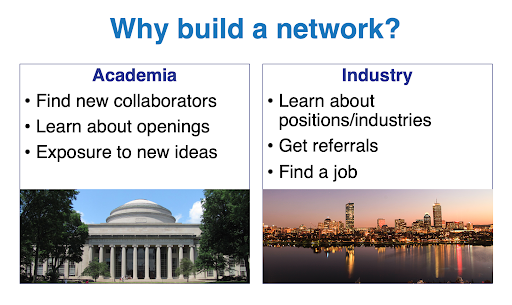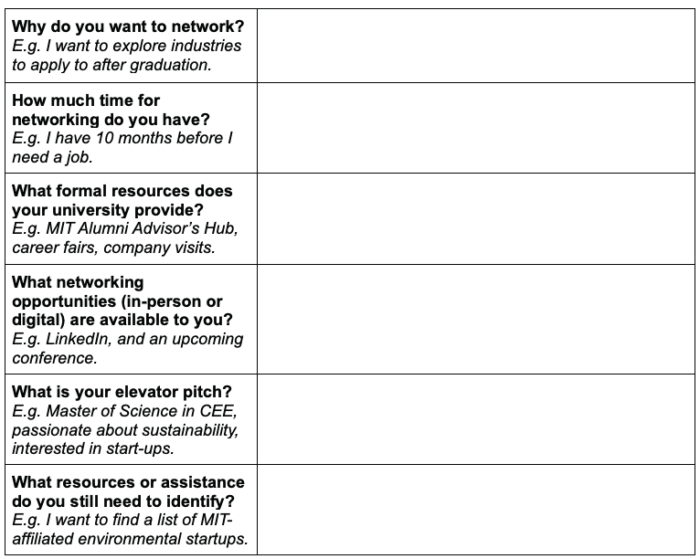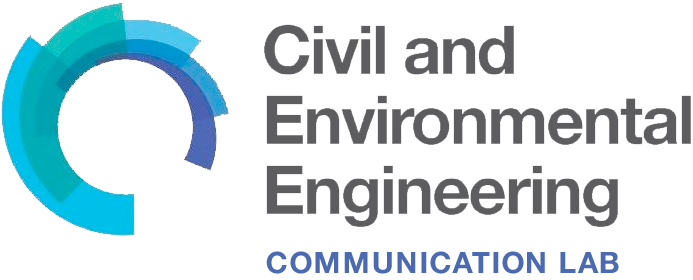By Trevor Cambron
Networking. For some it is a loaded word that induces a visceral sense of dread, while for others it is a natural part of the workday. In reality, networking is nothing more than the practice of cultivating personal and professional connections, though building a strong network takes time and intentional effort. In this article, I will discuss strategies, best practices, and opportunities for building a network at your university and beyond, including:
- When to begin networking;
- How to identify your reason for networking;
- How to use different types of online networking platforms;
- How to craft effective outreach messages using the GREAT framework; and
- How to prepare for and make the most of face-to-face networking opportunities.
Find your reason to network, and start early
Before the job search
While many people might realize the importance of networking in the midst of a job search, it’s never too early to begin building and expanding your network. The goal need not be immediate; having a strong network can have future value you may be unable to recognize in the present. Creating a strong network is important for all types of career paths, whether you’re pursuing industry or academic professions.
For those pursuing careers in industry, you can start learning about different professional trajectories or roles from the people who work in those positions. Or, for those in academia, you can gain exposure to new ideas and research collaborations even before any specific project emerges. In fact, each of these motivations have guided my own networking activities. For example, in the fall before graduating with my Master’s degree, I used the strategies I share in this article to connect with individuals working in industries and positions I was interested in potentially pursuing, knowing that I had many months left before I needed to have a job secured.

There are many reasons to network, and being specific about your goals will guide your journey!
During the job search
During your job search, or in the months leading up to one, networking can help you narrow your search, and boost your application. Tapping into your network might allow you to learn about opportunities that might not yet be publicly posted, which is especially important for more senior roles. A referral from a current employee could also push your application to the top of the stack, making networking an important way to improve your odds of getting that first interview.
No matter what stage in your career you find yourself, taking some time to reflect on your future goals is important to focus your networking efforts. The aim of networking is to make connections and have conversations that help you achieve your goal.
So before you embark on your networking journey, it is worth taking the time to reflect:
- What are your short- and long-term career goals?
- Why do you want to expand your network?
- What do you want to learn and who can provide that information?
- What is the timeline you are working with?
- What would success in this networking process look like in a few months? A few years?
In the rest of this article, I will focus on how to network effectively using common online platforms such as LinkedIn, connecting on video calls, and when attending in-person events.

When it comes to building your network, cast a wide net. Even your current network probably includes more people than you think!
Build online connections
Online networking is one of the most convenient and low-barrier forms of networking. The three most important platforms are LinkedIn, Handshake, and your university’s alumni network.
LinkedIn has become a near-universal job board while also facilitating professional networking through the “connections” feature. When looking at a job posting or a company’s page, LinkedIn will list your connections, company alumni, and university alumni who have some affiliation with the company. Recruiters and hiring managers may also reach out to you via LinkedIn, and in my experience this can be a great way to initiate a conversation after sifting through the uninteresting and irrelevant messages.
Handshake
Handshake shares LinkedIn’s role as a widely used job board, but is targeted toward students and recent graduates. That means that posted jobs are often a better match for early career job seekers. Additionally, your university might publish lists of companies interested in hiring alumni as well as those attending upcoming job fairs, as the MIT Career Advising & Professional Development (CAPD) Office does. For more information on this platform, check out the MIT CAPD’s guide to Handshake. I have found Handshake to be very useful for determining which jobs and career events are of interest.
Alumni databases
Lastly, I strongly recommend that you investigate your university’s online alumni network. For example, the MIT Alumni Advisor’s Hub is an excellent resource for MIT students to directly connect with MIT alumni, who have signed up to be listed as “advisors” for students and fellow alumni. While the site assigns scores to advisors based on the similarity of their experience with your interests, you can also search for specific terms, such as job title or company. An advisor’s profile will detail their work and educational experience, list specific conversation topics you can reach out about (e.g. career conversations, mock interviews, work-life balance, etc.), and allow you to suggest times that would work for both of you to meet online. I met with several people from the Advisor’s Hub, and found all of my conversations to be encouraging and helpful! If you’re not sure whether your university has an alumni database, contact your school’s Career Services program or your department’s academic administrator.
Craft your GREAT message
Regardless of which platforms you use for online networking, in order to initiate a connection you will need to send an introductory message to someone that you don’t know. For many people, this is one of the least familiar and most intimidating aspects of networking, which can be a substantial barrier to making new connections. It is important to keep in mind that most people want to be helpful and are willing to share their experiences, especially when engaging with those that are early in their career! That being said, you will need to show that you are being thoughtful and intentional in your outreach, or to put it more bluntly, that you are someone worth investing time in. It goes without saying that kindness on your part is the best way to ensure kindness on theirs.
In crafting your message, you must carefully consider why you are reaching out to this specific person, and why you want to have a conversation. Remember too that your initial message should be short–you just want to initiate a conversation, not give a monologue! Fortunately, most effective messages share a similar structure. To remember the key parts of an effective message, I’ve created a helpful mnemonic: GREAT.
Greetings. Just like any other interaction, start with saying hello! If you don’t know this person, you might want to give a brief introduction: “I am a graduate student at MIT studying X with a background in Y from Z.” If you are reaching out to an existing connection, give them a short professional update, if relevant: “Since I saw you last, I’ve graduated with my Masters and have recently begun my job search.”
Reason. Explain the context of why you are reaching out to them, specifically: “I saw that you recently began your role as Lead Engineer at the Tech Institute.”
Express interest and purpose. Express interest in their position, company, or research, and state what you hope to learn from them: “I am very interested in becoming an engineer at the Tech Institute, and would love to hear about your background and how your experience brought you to your current position.”
Ask for a response. Be very explicit about what you are asking this person to do, so they know the desired outcome of this initial outreach: “Would you have time for a 30-minute conversation some time in the next couple weeks?”
Thank you. Remember that this person is volunteering their time to help you, so you should express gratitude. But as always, don’t over do it: “Thank you in advance for your time, and I hope to connect soon!”
If you can remember these key ingredients you will send GREAT messages. The GREAT framework is applicable for many kinds of messages, including this example email I drafted:

In this example email, my subject line – “MIT CEE student looking to connect over climate tech experience” – immediately indicates who I am and why I am writing to this person. Inboxes can pile up quickly and you want to ensure your message gets read.
Some further advice to keep in mind when connecting online:
- Once you set a time for a meeting, do not change it. The other person is volunteering their time, so be sure to be respectful.
- Try to cultivate a genuine connection by expressing real interest and showing enthusiasm in a way that is authentic for you. If the conversation content is not interesting, that could indicate that the role/industry is not the right fit, or that you might try reaching out to someone else to hear a different perspective.
- Don’t forget to follow up with a “thank you” email. This is especially important if you want to reinforce next steps, such as getting further connected with someone else or securing a referral. If you do get connected with someone else, you can mention that in your outreach message: e.g. “Celeste recommended I contact you to learn more about your experiences in the industry.”
Connect face-to-face
Conferences, workshops, and other presentations are ripe with networking opportunities. Whether you set up a video call with a new connection or are attending an in-person event, face-to-face networking is an essential skill. This type of networking might happen after fornal talks or poster presentations at conferences, or at booths during job fairs. Deliberately seeking out new connections during events like these is one of the best ways to introduce yourself to new people and build confidence. Thankfully, these types of conversations are expected and wanted by attendees!
Formal presentations
For example, after someone delivers a talk, it is very common for audience members to linger and chat about the work. This provides the perfect opportunity for you to ask the speaker any questions you didn’t have time to ask, or connect with them about their paper that you recently read. If they are already surrounded by other interested attendees, don’t be afraid to join the conversation. You can also ask for their contact information, and offer yours as well, to follow up later.
Poster sessions
Poster sessions also provide a great opportunity to connect with people working in your field. Depending on the conference, you may be able to read abstracts ahead of time to plan who you want to connect with. While visiting their poster, you might ask for their contact information to follow up later. You can let them know why you want to connect, such as whether you’re hoping to learn more about their research project and/or professional experience.
Networking events
Many conferences also have dedicated networking sessions. Structured networking events can be intimidating, but remember that everyone is there to talk to new people. The conversations can be fluid and natural! Don’t be afraid to share information about yourself, which can be a great way to elicit information from others. Worlds are very small, so someone may know your colleague or advisor, or may have some sort of connection to your alma mater. Asking questions is also important. The more questions you ask, the more you learn about others, and the more you share about yourself, the better connections can be made.
Prepare an elevator pitch
During any introductory conversation, whether at a conference, job fair, or online, you will likely be asked some variant of “tell me about yourself.” Without preparation, this seemingly straightforward prompt can leave even the most sure-footed networker tongue-tied. Where do I begin? What should I highlight? These are the types of questions you will answer for yourself by preparing your elevator pitch.
As concisely as possible, you need to get across:
Who are you? What is your background?
What do you do? What is your current role? What are your research and/or professional interests?
What are your skills? Is your skillset aligned with the requirements of the role and/or company of interest?
What are you looking for? This is where you bring in your ask, whether that involves a new position, collaboration, exploration, or specific information.
Adapt to your audience and context
The way that you end your elevator pitch will vary depending on the audience, setting, and your goal. The following table summarizes some common settings, and bolds key words and phrases for each.

Although you want to enter networking situations with your key points in mind, you will likely not be able to give your entire elevator pitch verbatim. Instead, allow the content to flow throughout the course of the conversation. The quantity and depth of information that you share about yourself will depend on the nature of the interaction– the audience and context– but it’s always a good idea to keep in mind the key highlights of your background. This will enable you to selectively share specific information about yourself and your goals throughout the conversation.
Be sure to ask questions
During your conversation, whether in an interview setting, job fair, or informal chat, beyond sharing your elevator pitch you should also come prepared to ask questions. Questions are not only a great way to resolve any uncertainties you might have, but they can be a great way to demonstrate interest and set yourself apart from others. For instance, a question can help you demonstrate knowledge on a subject, show particular insights on a field or topic, and express genuine curiosity. Your questions should be tailored to the specific individual or group you are addressing, and the labs/companies with which you are engaging. Common themes involve daily activities, team dynamics, and growth opportunities, which otherwise might be difficult to deduce from a job listing or lab/company description on a website. As mentioned earlier, asking questions also communicates your curiosity and desire to learn from your audience.
Follow through with your networking goals
Networking can feel overwhelming, but building your network is as easy as these four steps:
- Find your reason to network.
- Identify opportunities to connect with others.
- Craft your story.
- Start networking!
To help jumpstart your journey, I’ve created a Networking Plan worksheet. After answering these prompts, you’ll be ready to start building a network in a deliberate, goal-oriented way.

You can download a .pdf of this worksheet at the end of this article.
Take the journey in stride
It is crucial to be intentional about each of these steps, and know that while a strong network will take time to build, in the end it will be worth the effort. There might be unanswered messages, awkward conversations, or people you wouldn’t want to talk to again, but that’s all part of the process. Building a network is all about preparation and proactive outreach. If you start early, you will have time on your side.
Finally, remember that your network also includes the social connections you make outside of formal networking situations. The relationships that you build in school and the workplace could be some of your most important professional connections, so it could pay off to take some time to meet new people, join organizations and clubs, and have fun.
Lastly, remember to seek out resources that will prepare you for effective networking. The MIT CAPD has compiled a plethora of networking resources, and you ask your peers, instructors, and mentors about their own networking approaches. If you are an MIT student or postdoc seeking help with networking you can also make an appointment with one of our Comm Fellows. We are happy to help you identify opportunities, craft messages, and practice networking!
